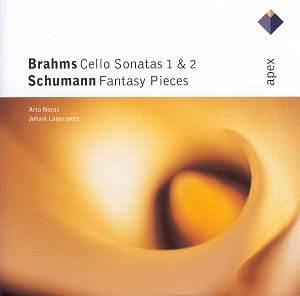Arto Noras is an excellent cellist with a strong technique,
and he brings real insights into this repertoire. He plays with a clear
sense of line and direction, aided and abetted by his sensitive accompanist.
Of course in Brahms's sonatas the piano part cannot
be relegated to the description 'accompaniment', since the concept is
one of partnership of equals. That equality is not quite achieved here,
partly because the recording, which is otherwise very good, tends slightly
to favour the cello. Perhaps also it is because Noras has the bigger
personality of the two artists.
The two Brahms sonatas are typically masterly examples
of the composer's genius in chamber music. Each has its own particular
personality, but each is equally sure of the partnership of cello and
piano, and of the balances between the strongly characterised themes.
These things are best shown through a comparison of the opening movements.
In Opus 38 Brahms opts for a broad Allegro non troppo, and Noras responds
with gloriously full tone in the melodic arch of the principal theme.
In the second Sonata, Opus 99, the Allegro is qualified differently,
by a Vivace which insists on the momentum being intensified and the
rhythm therefore carrying the message. Here also the artists seem to
capture the essential spirit of the music, and their reading of it is
truly vivacious.
In fact the comparisons between the two sonatas are
endlessly fascinating. Taking into account his relatively relaxed opening
tempo in Opus 38, Brahms boldly dispenses with a conventional slow movement,
even opting for a three rather than a four-movement design. The central
movement is marked Allegretto quasi Menuetto, and Noras and Lagerspetz
again respond sensitively to the challenge of interpretation. But when
in Opus 99 a genuine slow movement is on offer - a true Adagio, this
- their performance is deeply felt.
On CD the Brahms sonatas would make a short programme,
and the artists add a highly appropriate extra item, in the form of
Schumann's three Fantasiestücke. These were written relatively
late in Schumann's tragically short life. They were completed in 1849,
not long before he encountered the young Brahms and took him under his
wing. Again the interpretations are highly enjoyable, and so too the
music, which is rather less well known than the Brahms items.
Terry Barfoot


